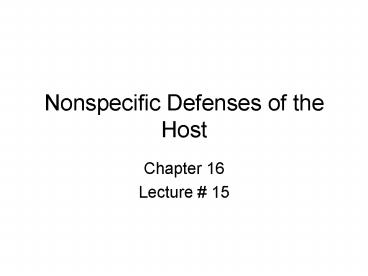Nonspecific Defenses of the Host - PowerPoint PPT Presentation
1 / 31
Title:
Nonspecific Defenses of the Host
Description:
Neutrophils are the most important of the granulocytic phagocytes ... Phagocyte migration: Phagocytes stick to the lining of blood vessels and squeeze through ... – PowerPoint PPT presentation
Number of Views:52
Avg rating:3.0/5.0
Title: Nonspecific Defenses of the Host
1
Nonspecific Defenses of the Host
- Chapter 16
- Lecture 15
2
Introduction
- The ability of body defenses to ward off disease
is _______________________ - Lack of Resistance is called ___________
- ___________ resistance is all body defenses
protecting against any kind of pathogen - ___________ resistance is immunity by means of
antibodies against specific microorganisms (next
lecture)
3
Overview of the Bodys Defenses
4
Mechanical Factors
- Intact skin with its waterproof ____________ do
not allow microbial invasion - Some pathogens can penetrate mucous membranes
- Tears wash the eyes continuously-and more when
irritants are encountered - Saliva ____________ organisms from teeth and gums
- Mucous traps microorganisms in respiratory and GI
tract - The __________ ___________
- Urine flow and the flow of vaginal secretions
move microorganisms out of the body
5
Intact skin
6
The Ciliary Escalator
7
The Ciliary Escalator
8
The Lacrimal Apparatus
9
Chemical Factors
- ____________ unsaturated fatty acids-inhibit
growth of some pathogenic bacteria (acne organism
can metabolize sebum) - Perspiration washes microorganisms off the skin
- __________________ (can break down cell walls of
G and to a lesser extent G-) is found in tears,
nasal secretions, saliva and perspiration - Gastric juice low pH prevents microbial growth in
the stomach - Normal microbiota prevent the growth of many
pathogens
10
Phagocytosis
- Ingestion of microorganism or foreign matter by a
host cell - Phagocytes are _______ __________ cells or
derived from them
11
Phagocytosis diagram
12
Phagocytosis cell
13
Formed Elements in Blood
- Blood consists of plasma (fluid) and cells and
cells fragments (formed elements) - Leukocytes (3 kinds) different ones increase
during different kinds of infections!
Differential Counts - G______________( Eosinophils, Basophils,
Neutrophils) - M____________________ and
- L____________________ (lymphatic system)
- Infections increase in _____________ ( some
decrease white cells!) - Bacterial components, lipids and _________,
activate phagocytes
14
Formed Elements
15
Leukocytes
16
Lymphatic System
17
Actions of Phagocytic Cells
- Neutrophils are the most important of the
granulocytic phagocytes - Enlarged _____________ become wandering
macrophages (super phages) and fixed macrophages
located in selected tissues - During the early stages of infection,
g__________________ predominate,
m________________ predominiate as the infection
subsides
18
Macrophages
19
Mechanisms of Phagocytosis
- C_____________ chemical signals which attract
phagocytes - Phagocyte then adheres to the microbial cells
- Process enhanced by coating the microbe with
__________________ proteins - Pseudopods of the phagocyte engulf the microbe
and enclose it in a ________ vesicle - Many phagocytized microorganisms are killed by
lysosomal enzymes and oxidizing agents - Some microbes are not killed and even
____________________ in phagocytes
20
Phagocytosis
21
The Inflammatory Response
- Inflammation is a bodily response to cell damage
- R_________, pain, heat, swelling
- Vasodilation and Increased Permeability of Blood
Vessels cause by histamines, kinins,
prostaglandins - Blood ________________ around an area of
infection (an abcess) to inhibit the spread of
infecting
22
The Inflammatory Response
- Phagocyte migration
- Phagocytes stick to the lining of blood vessels
and squeeze through into inter- cellular space - Pus is the accumulation of damaged tissue and
dead microbes, g____________ and
m_________________________
23
The Inflammatory Response
- Fever Caused by bacterial _________ and
interleukin-1 which is released by phagocytes
when they ingest G- bacteria - A chill indicates a ________ fever, crisis or
sweating indicates that the body temperature is
falling
24
The Inflammatory Response
25
The Inflammatory Response (2)
26
Tissue Repair
- Tissue is repaired when the supporting tissue or
_____________ produces new cells (functioning
tissue)-a perfect repair - Supporting tissues repairs produce scar tissue
- Last part of the inflammatory process
27
Antimicrobial Substances
- The complement system a groups of serum proteins
which activate one another to destroy invading
microorganisms - C1 binds to antigen-antibody complexes to
eventually activate C3 protein. Factor B, f
factor D, factor P, and C3 bind to cell wall
polysaccharides to activate C3b - C3 activation can result in cell lysis,
inflammation or coating the microbe with protein - Complement deficiencies lead to increased
susceptibility to disease
28
Diagram of Complement System
29
Cytolysis
30
Interferons
- Interferons are antiviral proteins produced in
response to viral infection - Three types of Interferon A_______, B_________
and G_______________ - Alpha and Beta interferons induce uninfected
cells to produce ______________ proteins that
prevent viral replication - Gamma Interferon activates n______________ to
kill bacteria - Interferons are ______________ specific, but not
_____________specific
31
Alpha and Beta Interferons































